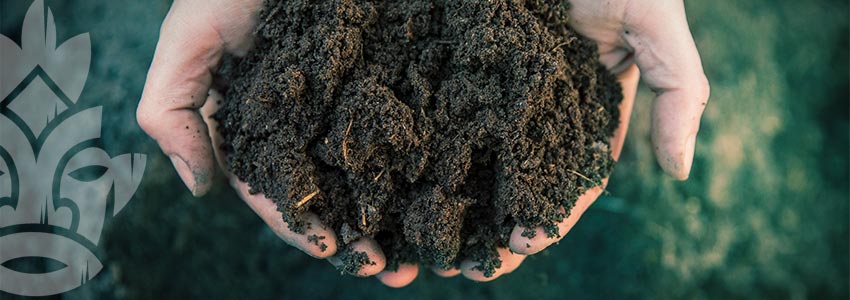Don't have an account?
Register NowYou have to add to cart at least 5 bottles or any program to make checkout.
- BlogUnderstanding Soil Porosity for Cannabis Growing
Understanding Soil Porosity for Cannabis Growing
Published: October 22nd, 2020
Categories:
Cannabis Cultivation
For many people, growing their own cannabis plants could be a very ambitious and tedious endeavour. Those with a green thumb are the exception, but for the majority who aren’t, there are a lot of moving parts to understand and get a good grasp on.
Let’s take soil porosity, for example. If you’re growing for the first time, this is a completely new language to you. The only way to obtain information is if someone educates you, or if you do your own research. Either way, you’ll take in a ton of data that you likely won’t remember when you need to put it to use.
But this article should help you comprehend things a lot better. We’ll simplify these important concepts so you can digest them and put them to good use. After reading this, you should hopefully have enough knowledge to arm yourself once you begin your growing venture.
What Is Soil Porosity?
Try grabbing a clump of soil and piling it on the palm of your hand. Looking at it closely, you’ll observe some pockets or gaps in an otherwise consistent clump. Soil porosity is all about those spaces left uncovered. These gaps are meant to hold water, air, and other gases, and this is an essential factor when growing plants, including cannabis.
When it comes to growing weed, you want large-enough pores to allow water to drain, but small-enough pores to absorb the water effectively.
A very porous soil holds less water. As a result, nutrients leach out quicker, which also makes fertilisers a lot less effective. On the other hand, a soil with low porosity is likely to get over-saturated with liquid, causing issues with plant health.
Pore Size Categories

Here are a few more things to remember: One, soil porosity influences oxygen concentration. The larger the pore, the more air exchange. Inversely, factors that influence porosity include soil structure, organic material, and compaction. The finer the texture, the more water it can hold.
Now, let’s now delve into the pore sizes, which are divided into four main categories:
- Cryptopore: These pores are extremely tiny in size; so tiny, in fact, that microorganisms, no matter how small, aren’t able to penetrate through them. Because of this, microbial decomposition becomes less likely
- Ultramicropore: Similar to cryptopores, ultramicropores aren’t a sustainable habitat for microorganisms. These types of pores are determined by soil texture and organic matter, and aren’t impacted by compaction.
- Micropore: Water stored in micropores shows very little to no movement. Plants will be able to extract the water from within, but the water itself is not mobile.
- Macropore: Ideally, you want to pick soils with macropores that can store and drain water. Physical interruptions like roots cause macropores to form.
The Importance of Soil Porosity in Cannabis Growing

Like any plant, cannabis survives on the water and nutrients from the soil. This is where porosity comes into play. For cannabis roots in particular, you want soil with larger pores to leave room for growth. Your soil should allow the formation of a root network to hold the stem and entire plant steadily upright. You don’t want it to be too loose, though. That may injure the roots and break them free of their bonds, which could affect their stability.
You also want the soil to drain water effectively. A soggy soil hinders air from reaching the roots, and that lack of oxygen will impede the plant’s growth and survival.
What Makes Soil Porous?

The answer to this question is multipronged. A few factors make soil porous, such as compaction, structure, particle texture, and the quality of organic material mixed with it. In the case of silt and clay soils and their finer textures, they have the ability to hold more water than their sandy and coarse counterparts.
But if you know the proper care techniques, you can control the porosity of the soil in your own grow. It all comes down to the thorough mixture of organic materials. The best organic additives include peat moss and garden gypsum.
Let’s take garden gypsum, for example. Adding it to clay soil opens up the pore space between soil particles. In turn, the water and other nutrients that were left trapped within the micropores get opened up and unlocked, allowing some much-needed oxygen to come in. The end result is healthier, more robust plants flourishing in your garden.
How to Make Soil Less Porous

But what if your soil has become too porous for your liking? You can also make adjustments for that. Keep this in mind: Soil that is too porous won’t be able to hold water and nutrients, so you want to strike a fine balance. If you find your soil to be on the extreme end, add clay into the mix.
As experts advise, you’ll need about five percent clay thoroughly mixed six inches deep into sandy, overly porous soil. To top that off, add in some organic material three inches deep.
Soil Porosity: Knowledge Is Power

Hopefully we were able to provide you with sufficient information about soil porosity for your cannabis growing venture. The good thing is, you can also use this knowledge when cultivating any plant of your liking. Who says you need a green thumb to care for plants? Just follow the necessary steps, and you’ll be good to go.





